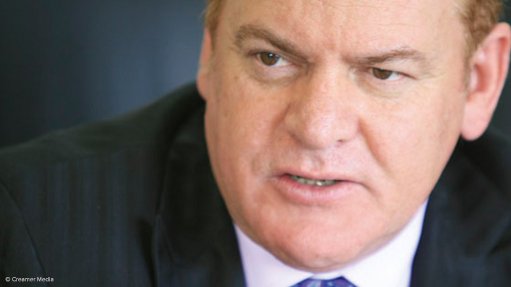
Gold Fields CEO Nick Holland
Photo by: Creamer Media
JOHANNESBURG (miningweekly.com) – Capital is not as easily available to gold mining companies as it used to be. Gold producers are having to compete with gold-linked alternatives and can no longer rely on equity as a guaranteed means of financing projects or addressing balance sheet gearing.
Making these points at the Australasian Institute of Mining and Metallurgy Global Mining Leaders Conference in Perth on Tuesday, Gold Fields CEO Nick Holland said share registers of gold companies had evolved to the extent of passive/index funds, which do not provide equity funding, making up a bigger proportion of share registers then traditional gold investors.
Moreover, the shift to indexing has been most noticeable in the US where 36% of funds are now passively managed compared with 17% ten years ago.
Unlike active managers, index managers may not sell poorly run companies if they fall in the index and therefore tend to hold positions for long periods.
Equity funding does not appear to be as readily accessible as it used to be. Despite gold equities appreciating markedly in 2016, the majority of funding used by the producers in 2017 and 2018 has been debt.
Index funds will not provide funding but will look to impact how a company is run through voting and engagement.
With equity funding proving harder to access, debt funding has far outweighed equity funding and gold-mining companies are having to tap non-traditional funding sources, including streaming. Those reluctant to take on too much debt are hedging to protect cash flows.
Gold companies are having to embark on smaller, more affordable projects that are scalable, while collaborating and joint venturing to lower risk.
Alternative gold investments like exchange traded funds valued at $84.6-billion were taking investment away from gold equities, which needed to offer attractive risk-adjusted returns to remain a competitive investment proposition.
Near term cash flow was having to be balanced against long-term sustainability and capital expenditure cutbacks had possibly been too deep. Mine production has peaked and greenfield exploration has all but dried up.
A construction decision is yet to be made on 30% of global reserves and the World Gold Council estimates an incentive price of $1 500/oz to maintain global production at current levels.
Concerning is the decrease in sustaining, stay-in-business capital from $310/oz in 2012 to $176/oz last year.
Investors were unhappy about declining production profiles, poor capital allocation, low shareholder return, high management compensation and were demanding low costs, increasing free cash flow and positive exploration results, said Holland, one of the longest-serving gold executives.